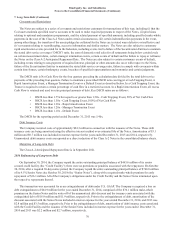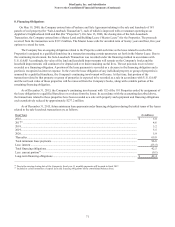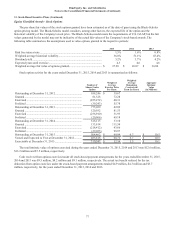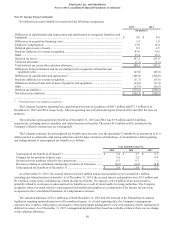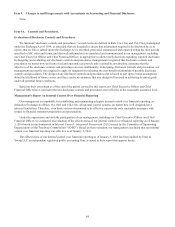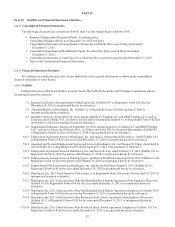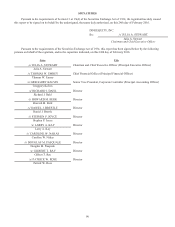IHOP 2015 Annual Report Download - page 100
Download and view the complete annual report
Please find page 100 of the 2015 IHOP annual report below. You can navigate through the pages in the report by either clicking on the pages listed below, or by using the keyword search tool below to find specific information within the annual report.
DineEquity, Inc. and Subsidiaries
Notes to the Consolidated Financial Statements (Continued)
Note 15. Income Taxes (Continued)
80
Net deferred tax assets (liabilities) consisted of the following components:
2015 2014
(In millions)
Differences in capitalization and depreciation and amortization of reacquired franchises and
equipment ................................................................................................................................... $ 4.8 $ 4.8
Differences in acquisition financing costs.................................................................................. 1.8 1.8
Employee compensation............................................................................................................. 13.0 14.4
Deferred gain on sale of assets ................................................................................................... 8.3 6.5
Book/tax difference in revenue recognition................................................................................ 43.9 39.6
Other ........................................................................................................................................... 35.4 35.9
Deferred tax assets...................................................................................................................... 107.2 103.0
Valuation allowance.................................................................................................................... (1.1) (1.1)
Total deferred tax assets after valuation allowance.................................................................... 106.1 101.9
Differences between financial and tax accounting in the recognition of franchise and
equipment sales....................................................................................................................... (43.0)(48.0)
Differences in capitalization and depreciation (1)................................................................................ (288.9)(294.6)
Book/tax difference in revenue recognition................................................................................ (11.7) (15.6)
Differences between book and tax basis of property and equipment......................................... (14.2) (11.4)
Other ........................................................................................................................................... (17.8) (20.5)
Deferred tax liabilities ................................................................................................................ (375.6) (390.1)
Net deferred tax liabilities .......................................................................................................... $ (269.5) $ (288.3)
_____________________________________
(1) Primarily related to the Applebee's acquisition.
The Company had gross operating loss carryforwards for state tax purposes of $60.7 million and $77.1 million as of
December 31, 2015 and 2014, respectively. The net operating loss carryforwards expire between 2016 and 2030 for state tax
purposes.
The total gross unrecognized tax benefit as of December 31, 2015 and 2014 was $3.9 million and $3.4 million,
respectively, excluding interest, penalties and related income tax benefits. The entire $3.9 million will be included in the
Company's effective income tax rate if recognized.
The Company estimates the unrecognized tax benefits may decrease over the upcoming 12 months by an amount up to $1.0
million related to settlements with taxing authorities and the lapse of statutes of limitations. A reconciliation of the beginning
and ending amount of unrecognized tax benefits is as follows:
Year Ended December 31,
2015 2014 2013
Unrecognized tax benefit as of January 1...................................................... $ 3.4 $ 2.7 $ 6.7
Changes for tax positions of prior years ........................................................ 1.0 1.2 0.8
Increases for tax positions related to the current year.................................... 0.1 0.1 —
Decreases relating to settlements and lapsing of statutes of limitations........ (0.6) (0.6) (4.8)
Unrecognized tax benefit as of December 31................................................ $ 3.9 $ 3.4 $ 2.7
As of December 31, 2015, the accrued interest was $4.9 million and accrued penalties were less than $0.1 million,
excluding any related income tax benefits. As of December 31, 2014, the accrued interest and penalties were $3.9 million and
$0.1 million, respectively, excluding any related income tax benefits. The increase of $1.0 million of accrued interest is
primarily related to an increase in unrecognized tax benefits as a result of recent audits by taxing authorities. The Company
recognizes interest accrued related to unrecognized tax benefits and penalties as a component of the income tax provision
recognized in the Consolidated Statements of Comprehensive Income.
The valuation allowance of $1.1 million as of both December 31, 2015 and 2014 related to the Massachusetts enacted
legislation requiring unitary businesses to file combined reports. As of each reporting date, the Company’s management
considers new evidence, both positive and negative, that could impact management’s view with regards to future realization of
deferred tax assets. As of December 31, 2015, management determined that, based on available evidence, there was no change
to the valuation allowance.


